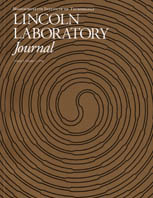Publications
Volume 9, Number 1
 |
|
A Terrestrial Air Link for Evaluating Dual-Polarization Techniques in Satellite Communications We describe the radio frequency design and test data for an experimental terrestrial air link, which simulates a satellite-to-ground communications link operating in a dual-polarization frequency-reuse mode within the 17.7-to-21.2-GHz band. The terrestrial air link comprises a transmit site located on Mount Pack Monadnock in Temple, New Hampshire, and a receive site 42.2 km away in Westford, Massachusetts. The transmit site uses a 1.8-m-diameter dish, and the receive site uses an 18.3-m-diameter dish enclosed by a 28.4-m-diameter air-supported radome. The terrestrial air link provides a test bed for evaluating atmospheric effects of fading and scintillation, along with amplitude, phase, and polarization distortion that can compromise the performance of satellite-to-ground communications systems. The test data indicate that the terrestrial air link has a high degree of cross-polarization isolation under clear-air conditions and is well suited for evaluating dual-polarization frequency-reuse techniques. Superconductivity for Improved Microwave Ferrite Devices We have demonstrated a new class of radio frequency (RF) devices that combine low-insertion-loss superconductor circuits with variable magnetization ferrites. The devices are designed to prevent penetration of the superconductor by DC magnetic fields associated with the ferrite, thus preserving the low RF loss of the superconductor while allowing interaction of the RF magnetic fields with the magnetized ferrite. A prototype ferrite-superconductor phase shifter that employs high-Tc YBa2Cu3O7 (YBCO) superconductor meanderlines has produced over 700° of differential phase shift at 9 GHz with a figure of merit exceeding 1000°/dB over a 2-GHz-wide frequency band. We have also demonstrated a three-port switching circulator by combining three low-loss superconductor meanderline sections with alternating T junctions on a ferrite substrate. This adaptation of two important technologies promises performance advantages that include lower insertion loss and reduced size and weight, compared to conventional techniques. By optimizing ferrite properties for use at cryogenic temperatures, we expect to achieve lower switching energies and faster switching speeds. High-Tc Superconductive Wideband Compressive Receivers Wideband compressive receivers are an attractive application of analog high-transition temperature superconductive (HTS) microwave filters. Chirp filters form the basis of compressive receivers, implementing a chirp-transform algorithm in the analog domain for real-time spectral analysis. HTS tapped-delay-line chirp filters are an enabling technology for instantaneous bandwidths greater than 1 GHz, and have evolved sufficiently to support dispersive delays as long as 40 nsec with multigigahertz bandwidths and time-bandwidth products in excess of 100. Long dispersive delays have been obtained by using a bonded/thinned-wafer technique to fabricate YBa2Cu3O7 stripline devices on 5-mil-thick, 2-in-diameter LaAlO3 substrates. In addition, a 3-GHz-bandwidth HTS compressive cueing receiver was recently delivered to the Naval Research Laboratory to be flown on the High-Temperature Superconductivity Space Experiment (HTSSE), and demonstrations have been performed by combining HTS chirp filters with conventional compressive-receiver hardware. We propose a novel compressive cryoreceiver architecture that combines HTS, cryoelectronic, and advanced high-speed semiconductor technologies. The proposed receiver will rival the sensitivity of a narrowband receiver while providing unprecedented instantaneous wideband frequency coverage. An HTS compressive receiver is projected to be superior in overall size, weight, and power; its applications include electronic warfare and dynamic molecular spectroscopy for remote sensing. |
|